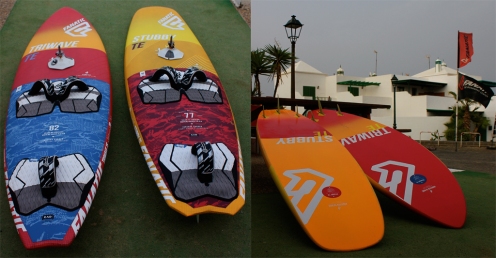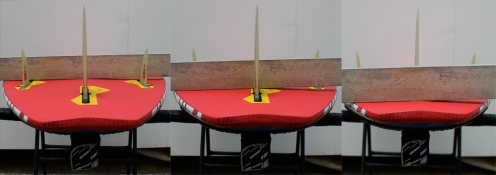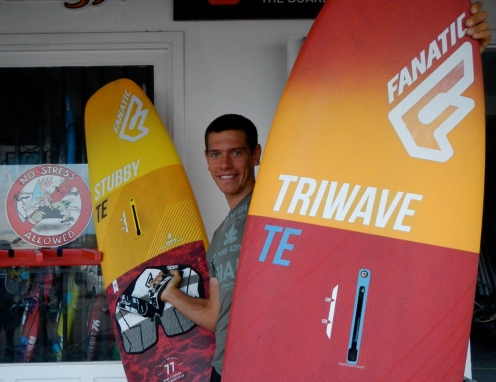FANATIC TRI FINS 2016
My first question on the launch of the Fanatic 2016 boards was, “Why have 3 Tri fin boards in the range?”
I will try to answer the question as the three boards, are very different. The sizes are different but this may help to answer design concepts.
So we have the Free Wave which has not changed but as always they have tweaked things in the construction for 2016. I will use my 86L. The Tri-Wave which has changed considerably, I can test the 82L and the Stubby 77L which is a totally new concept board.
Lets have a look at the 2 new shapes.
The Stubby, the planing machine. This board is very short but not so wide, 77L is 55 cm wide and 212 cm long and the 88L is 57.5 cm wide and 215 cm long. You have to get the volume and stability in there some how, so the first thing you notice is how thick it is in the middle of the board. The volume is all around the front foot strap.
The Tri-Wave, fast carving. 82L is 58 cm wide and 224 cm long, this is becoming a standard size for a wave board. The volume is evenly distributed.
On the stubby I notice there is a relatively flat section around the front foot strap and yes it is there on the Tri-wave but not as large. Speed.
The underwater shapes are very similar, a slight double concave ‘V’.
So where on a board do we command it to turn? The tail, so lets have a look at that.
The Free Wave has double concave ‘V’ throughout the board but under the back foot strap it goes into what I call a power ‘V’, which is in between the thrusters and the centre fin. It then goes flatter behind the centre fin.
The Tri-Wave now has this and they have taken it right to the back of the board. It has less concave in the ‘V’.
Now the Stubby has taken this a step further and changed it into a power channel. This board is really designed for generating power from the tail in the turns.
Looking at the outlines, these boards are very different.
So after looking at the shapes and setting the boards up with my normal settings, it was time to get on the water. ( Settings:- mast foot back, straps forward, thruster fins back and centre fin Forwards and of cause my 3.7m Hero.) On My Free Wave I always use, Maui Ultra Fins 9cm X Quad and 16.5 X Twin so I placed that size in the Stubby but used a 17.5 X Twin in the Tri Wave.
Of cause it was the Stubby I took out first. There were no waves on this session and on the inside almost no wind so I new this was going to be a challenge on this board. The fore and aft trim surprised me, it is Ok BUT boy you really notice it being only 55 cm wide. Very unstable, especially when you have almost no pressure in the sail. However once you get forward momentum there is a lot of active volume and stability. Once out to the wind line, front foot in the strap and off we go. (Must check some measurements as that was very easy.) This board accelerates very fast, back foot in and no problem with it being right at the back of the board. Going at full speed you do notice the wide tail but it is not a problem, however if you slow down a bit then it does get a bit bouncy. No problem just sail it very fast. One thing I did notice though, the speed fluctuates quite a lot. This will be due to it’s short length, so gusty conditions make it challenging for free sailing. It is very easy to get the board in the air and having your back foot right on the tail, an interesting feeling. As I said no waves but can’t wait to get some aerials. I also did some tests coming in to get an idea on what it would be like turning it on a wave……………… all I can say is GIVE ME SOME WAVES! Very very manoeuvrable.
So out on the Tri Wave. Jumping from the Stubby onto this makes it feel very stable. It has a comfortable feel sailing out with little wind. I mentioned that little flat section, yes this board accelerates faster than last years and flies upwind. A great improvement. Something else is different, the straps must be further apart, getting a bit of spin out and that could be a reason. Must check it. This board is for high speed carving so it’s going to be great on big waves. Especially with the slightly straighter outline. Go big or go home as the speed this board goes, you are going to go high.
Now back to those measurement questions.
These are only rough measurements to give me an idea of what is going on.
A.) Back position of the mast foot. Free Wave 124 cm, Tri Wave 121 cm, Stubby 116 cm. So yes the working section of the Tri and Stubby is further back.
B.) Front foot strap from mast foot. Free Wave 38 cm, Tri Wave 36 cm, Stubby 34 cm. This will explain why it was so easy to get into the front strap and go, on the stubby. 4 cm closer makes a lot of difference on how you can keep the mast upright/vertical.
C.) Foot strap spread. Free Wave 55 cm, Tri Wave 59 cm, Stubby 59 cm. Ha ha yes 4 cm wider, that would explain things with the Tri but why did I not have the problem on the Stubby? I think it may be something to do with the front foot strap position being closer to the mast, I can keep the mast more vertical.
D.) Back strap from the tail. Free Wave 30 cm, Tri Wave 26 cm, Stubby 18 cm.
Just for curiosity I took some width measurements. E.) Free Wave 54 cm, Tri Wave 52 cm, Stubby 50 cm. F.) Free Wave 37 cm, Tri Wave 34 cm, Stubby 35 cm. G.) Free Wave 12 cm, Tri Wave 14 cm, Stubby 16/27 cm. The Stubby has this diamond swallow tail so I have given 2 measurements.
After this first day of testing I have to say the Free Wave is such a great board and I am pleased they have not changed it. It is such a good bench mark to see how other boards work.
The New Tri Wave has taken many of the characteristics of the Free Wave, early plaining, speed and easier to use. It is still a more radical wave board but in some respects it makes it harder to choose between the FW and the Tri. If it is hard core wave sailing you are looking for, then this is your board. But if you are spending more days not in waves, volume may be the answer as if you place them in one group you have:- FW 116, FW 106, TW 99, FW 96, TW 89, FW 86, TW 82, FW 76, TW 74.
I have to try the Stubby in waves to give the full report on this board. It is going to be amazing but very special. I will be doing a separate test on this. My first thought is that I would prefer the 88L to have more stability in light winds, these are the conditions I like.
Thanks Noah for letting me use your boards.










hi great article! really inspiring! i’m willing to buy a wave board soon but i have big doubts between 3 solutions: triwave 81lt 2015, new triwave 82lt 2016 and freewave 86lt 2015. what is your suggestion?
i’m 69 kg and not a master on the waves (yet 😉 )
thanks
andrea
Hi Andrea.
This is not such a straight forward question.
The Triwave 81L is a very good board powered up but is not the simplest to get plaining or go upwind.
The Triwave 82L is also very good and planes earlier and is faster. The main issue is the foot strap position, they are further apart and further back. So this does not suit a less experienced rider.
The Freewave 86L is my board and I love it, it is easy and friendly. It is the fastest out of the boards and the earliest planing. As I am an advanced rider, I would like to have the option to have the mast foot and straps in the new position, as on the Triwave 2016, everything further back. So in fact all they would have to do is move the mast track.
So I think your main question should be, how powered up do you like to sail? So the logic would be. If you like to sail slightly under powered, Freewave, Over powered Triwave.
hi,
at the end of the day i bought the triwave 82 2016!
i tried it last weekend with 4,2 sail in very choppy and gusty conditions with almost no waves. it appeared to me to be a very reactive board but somehow also very nervous. great upwind capabilities but the point you where underlining to me about the distance between the footstraps is so true.. i think i will need to sail it in more proper conditions and to find the right fins regulation to get the most from it. i had just the feeling that it is not such “plug and play” board as it is described. definitely a real wave board and not an allround one. maybe the freewave (that by the way is my 95 lt board for less windy condition, 2012 version) would have been a less radical solution.
thanks for any suggestion or futher comments!
andrea
Hi Andrea.
I am pleased to hear that you got the Tri Wave 82L 2016 and enjoyed your first run out. I went through some changes I tried in this article:-
If you are finding the board a bit to nervous at the moment, move the side fins forward and the centre fin back until you can learn to relax more at higher speeds and let the board run. Also having the mast foot in the centre of the box, or slightly forwards will also help to make the board less reactive.
This board is a radical wave board, so get the settings back to the loose mode as soon as you are comfortable.
I have Stubby 88 and weight 75kgs, what size Maui Ultra fins would you recommend for keeping drive and still keeping best surfing,
Stock fin is 19cm and 12 sides, feels like it could be looser.
The ‘X’ series fins give great grip at speed and are very loose. The X wave gives more lift and the X twin is faster. So maybe in X wave you go for an 18 cm and in X Twin the 18.5 cm. In X Quad say 10 cm and X tri the 11.5 cm. Think about how heavy you are with your back foot, if you sail with a lot of pressure with the back foot you can not go to small.
I have an F quad 89l (also due to your tip) and used it this year in side-off spot. I was more then happy with it, now thinking of extending the quiver with a FW96 or TW99 for really light or gusty wind days/spots, and becouse I’m sharing the kit with my wife.
My question is – do I notice the big difference between these two models.
Could you tell me what is the distance between the line between front straps front screws to the mast base in most back position (or to the begenning of the usable part of mastrack) in these two models – from your article I gues
FW=38-5,25=32,7cm?
and
TW=36-5,25=30,7.?
(5,25 for the half way of front strap along the diametral axis of the board).
My intention is – will I menage on a FW to keep the distance of the mast base to the line of front screws-front starps in similar value to my FQ89 (which is 34,8 – 36 cm as I’m using second hole from the front and mast base middle to midlle -1 cm), and be able to use the rig with similar boom height?
I’ve got also the question to the boom height setting – do you alter the settings for overpower/underpower conditions and if you change for example from a quad to freewave or triwave/stubby according to different rockers and different stance – distance mast base to front strap etc.
Fo last 3 seasons I’m trying to keep the rig as vertical as I can and finding the boom position in enough powered conditions on a waveboard quite a bit lower then earlier and definitly lower then shoulder when standing on the board, but on the other hand my wife (she is 170 cm) likes it only slightly below shoulder.
I know the theory of equal pressure on both legs – but I am curious what are your thoughts and your big experience with clients of different postures.
My weight is around 80kg (+-1kg) and 183 cm tall.
and use rather long harness lines – 32 inches
By the way – what do you mean as a “new stance” in your article – a straight back leg and vertical rig or something different?
Arthur, you ask a lot of questions and the answers are in my posts. If you are developing a new style, let me know how it goes. If you would like to have personal coaching, come and visit me. By the way, 32 cm/ inches lines are not long. When they are measured in inches, they are small, American style, 32 euro style is a lot longer.
Thanks, understand, anyway appraciate your articles. As to the harness lines I use the longest fixed lines Da kine has made last year (close to 80cm- and i wanted to buy 34″ – but not so easy to find. These ones set on 3 fingers apart are from my elbow to the end of my palm – start of my fingers – so definitly not very short ones.
As to the back leg straight I mean elements from slalom sailing, when on most courses trying to keep hips quite paralel to the axis of the board to close the sail (but not the gap).
My boom last season on FQ 89 was from 133-142 cm from the deck at 183cm of my height (depending on conditions) with mastbase 126 – 127,5 cm from tail. It was lawer then some 3 or more years earlier on older boards – but exactly the mast base was more forward from straps on them.